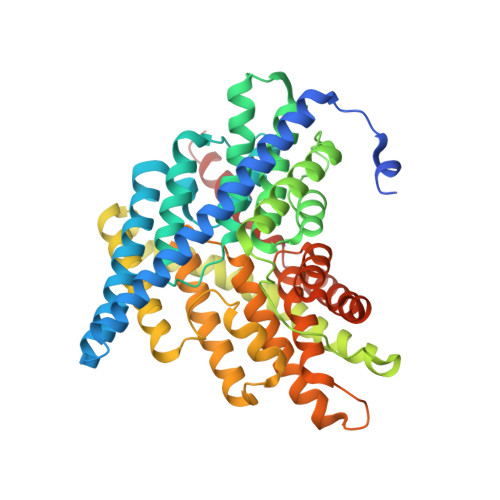Design, function and structure of a monomeric ClC transporter.
Robertson, J.L., Kolmakova-Partensky, L., Miller, C.(2010) Nature 468: 844-847
- PubMed: 21048711
- DOI: https://doi.org/10.1038/nature09556
- Primary Citation of Related Structures:
3NMO - PubMed Abstract:
Channels and transporters of the ClC family cause the transmembrane movement of inorganic anions in service of a variety of biological tasks, from the unusual-the generation of the kilowatt pulses with which electric fish stun their prey-to the quotidian-the acidification of endosomes, vacuoles and lysosomes. The homodimeric architecture of ClC proteins, initially inferred from single-molecule studies of an elasmobranch Cl(-) channel and later confirmed by crystal structures of bacterial Cl(-)/H(+) antiporters, is apparently universal. Moreover, the basic machinery that enables ion movement through these proteins-the aqueous pores for anion diffusion in the channels and the ion-coupling chambers that coordinate Cl(-) and H(+) antiport in the transporters-are contained wholly within each subunit of the homodimer. The near-normal function of a bacterial ClC transporter straitjacketed by covalent crosslinks across the dimer interface and the behaviour of a concatemeric human homologue argue that the transport cycle resides within each subunit and does not require rigid-body rearrangements between subunits. However, this evidence is only inferential, and because examples are known in which quaternary rearrangements of extramembrane ClC domains that contribute to dimerization modulate transport activity, we cannot declare as definitive a 'parallel-pathways' picture in which the homodimer consists of two single-subunit transporters operating independently. A strong prediction of such a view is that it should in principle be possible to obtain a monomeric ClC. Here we exploit the known structure of a ClC Cl(-)/H(+) exchanger, ClC-ec1 from Escherichia coli, to design mutants that destabilize the dimer interface while preserving both the structure and the transport function of individual subunits. The results demonstrate that the ClC subunit alone is the basic functional unit for transport and that cross-subunit interaction is not required for Cl(-)/H(+) exchange in ClC transporters.
Organizational Affiliation:
Department of Biochemistry, Howard Hughes Medical Institute, Brandeis University, Waltham, Massachusetts 02454, USA.















